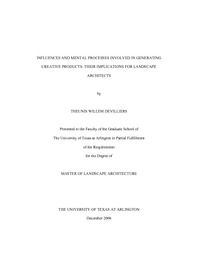
ATTENTION: The works hosted here are being migrated to a new repository that will consolidate resources, improve discoverability, and better show UTA's research impact on the global community. We will update authors as the migration progresses. Please see MavMatrix for more information.
Show simple item record
| dc.contributor.author | Devilliers, Theunis Willem | en_US |
| dc.date.accessioned | 2009-09-16T18:20:27Z | |
| dc.date.available | 2009-09-16T18:20:27Z | |
| dc.date.issued | 2009-09-16T18:20:27Z | |
| dc.date.submitted | January 2008 | en_US |
| dc.identifier.other | DISS-10126 | en_US |
| dc.identifier.uri | http://hdl.handle.net/10106/1863 | |
| dc.description.abstract | Creativity is the ability to bring something new into existence consciously with `something new' being a product resulting from a process initiated by a person (Barron, 1988.) It may be an idea, an artwork of acknowledged greatness, a scientific discovery, the solution to a problem, leadership abilities, or theories and products that are unique and novel (Barron, 1988.)Influences involved in generating creative products include the social and historical milieu in which creativity is carried out, a culturally defined domain, the creative person's personality, cognitive factors, and motivational characteristics. The topic of creativity is appropriate for landscape architecture because creative products are generated in this domain. Research of creative processes mostly explains scientific insight. It includes research on memory, intelligence, reasoning by analogies, problem solving and problem finding. These processes manifest through convergent, divergent, and analogous thinking tasks. This thesis tests this hypothesis: If participants' scores are high for a divergent task test, a convergent task test, and an analogous thinking test, then they will also achieve higher scores than the mean score of a testing group on a creative design assessment test. This will prove that landscape architect use the processes involved in scientific insight for creative design. Finding correlations between cognitive processes associated with scientific insight and design abilities of landscape architects, recognizes landscape architecture as a field where inventions, discoveries and novel products occur. The data was interpreted through statistical analysis. Although the hypothesis could not be proved irrefutably, correlations were found between some cognitive processes and creative design abilities. | en_US |
| dc.description.sponsorship | Taylor, Pat D. | en_US |
| dc.language.iso | EN | en_US |
| dc.publisher | Landscape Architecture | en_US |
| dc.title | Influences And Mental Processes Involved In Generating Creative Products: Their Implications For Landscape Architects | en_US |
| dc.type | M.L.A. | en_US |
| dc.contributor.committeeChair | Taylor, Pat D. | en_US |
| dc.degree.department | Landscape Architecture | en_US |
| dc.degree.discipline | Landscape Architecture | en_US |
| dc.degree.grantor | University of Texas at Arlington | en_US |
| dc.degree.level | masters | en_US |
| dc.degree.name | M.L.A. | en_US |
| dc.identifier.externalLink | http://www.uta.edu/ra/real/editprofile.php?onlyview=1&pid=1152 | |
| dc.identifier.externalLinkDescription | Link to Research Profiles | |
Files in this item
- Name:
- Devilliers_uta_2502M_10126.pdf
- Size:
- 964.6Kb
- Format:
- PDF
This item appears in the following Collection(s)
Show simple item record


